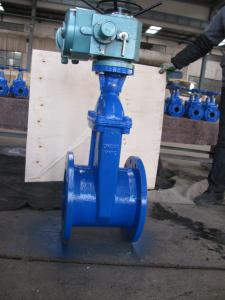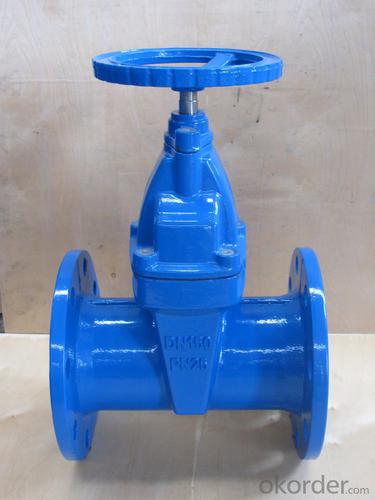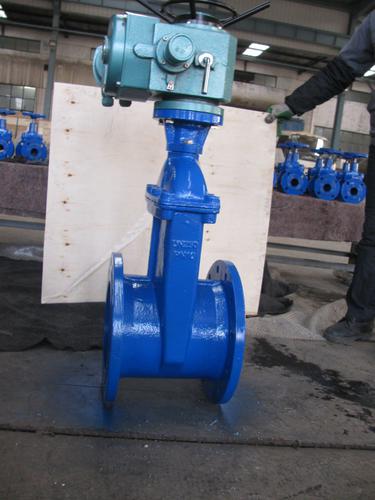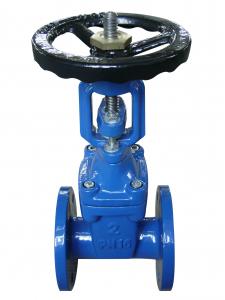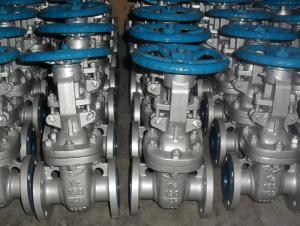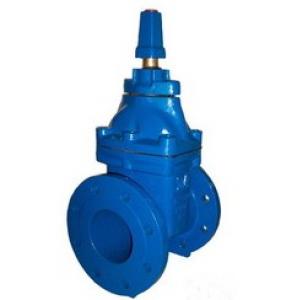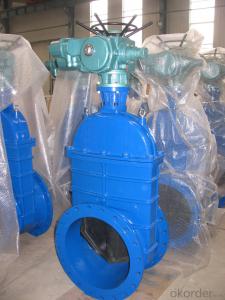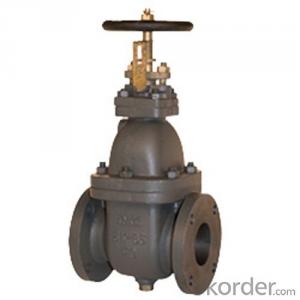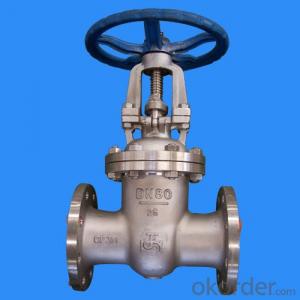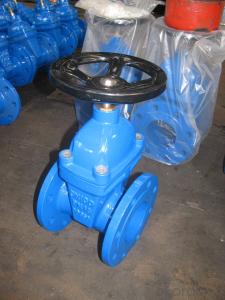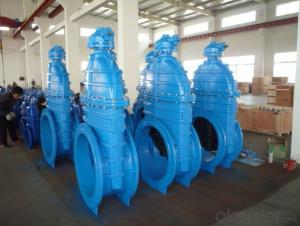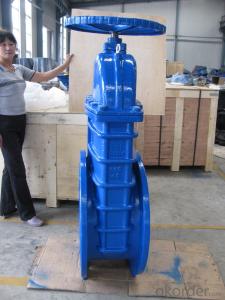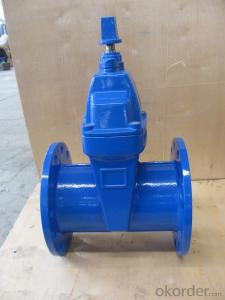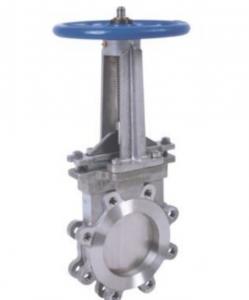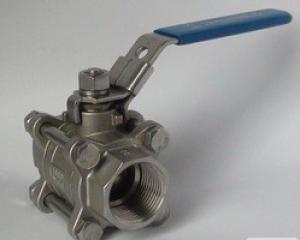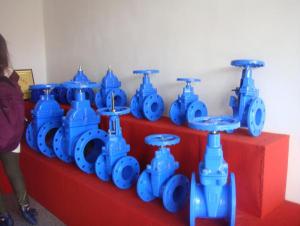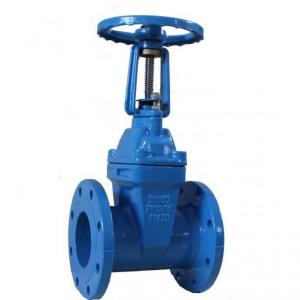DIN Cast Iron Resilient Seated Flanged Gate Valve F4
- Loading Port:
- Tianjin
- Payment Terms:
- TT OR LC
- Min Order Qty:
- 200 pc
- Supply Capability:
- 10000 pc/month
OKorder Service Pledge
OKorder Financial Service
You Might Also Like
1.Structure of Gate Valve Description:
A gate valve, also known as a sluice valve, is a valve that opens by lifting a round or rectangular gate/wedge out of the path of the fluid. The distinct feature of a gate valve is the sealing surfaces between the gate and seats are planar, so gate valves are often used when a straight-line flow of fluid and minimum restriction is desired. The gate faces can form a wedge shape or they can be parallel. Gate valves are primarily used to permit or prevent the flow of liquids, but typical gate valves shouldn't be used for regulating flow, unless they are specifically designed for that purpose. Because of their ability to cut through liquids, gate valves are often used in the petroleum industry. For extremely thick fluids, a specialty valve often known as a knife valve is used to cut through the liquid. On opening the gate valve, the flow path is enlarged in a highly nonlinear manner with respect to percent of opening. This means that flow rate does not change evenly with stem travel. Also, a partially open gate disk tends to vibrate from the fluid flow. Most of the flow change occurs near shutoff with a relatively high fluid velocity causing disk and seat wear and eventual leakage if used to regulate flow. Typical gate valves are designed to be fully opened or closed.When fully open, the typical gate valve has no obstruction in the flow path, resulting in very low friction loss.
2. Main Features of the Gate Valve:
• Valve body cavity using non-toxic epoxy resin,both inside and outside flashboard completely is coated with rubber
• Free of water pollution
• High manufacturing accuracy
• High strength
• Environmental protection and energy saving
• Good visual effect
3. Images

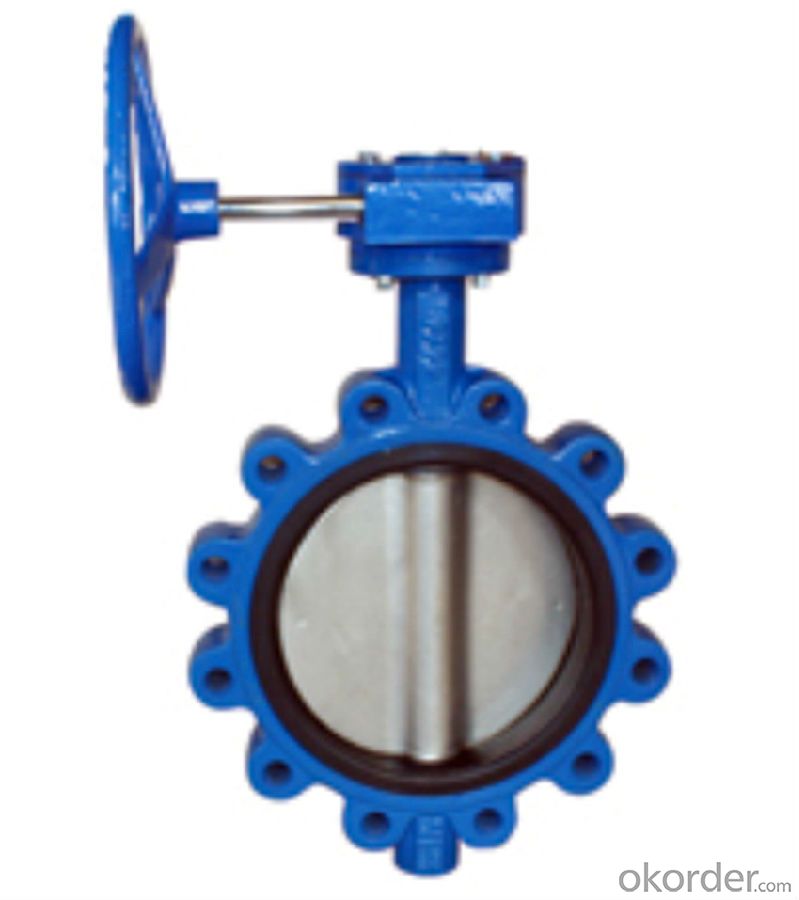
4. Gate valve Specification
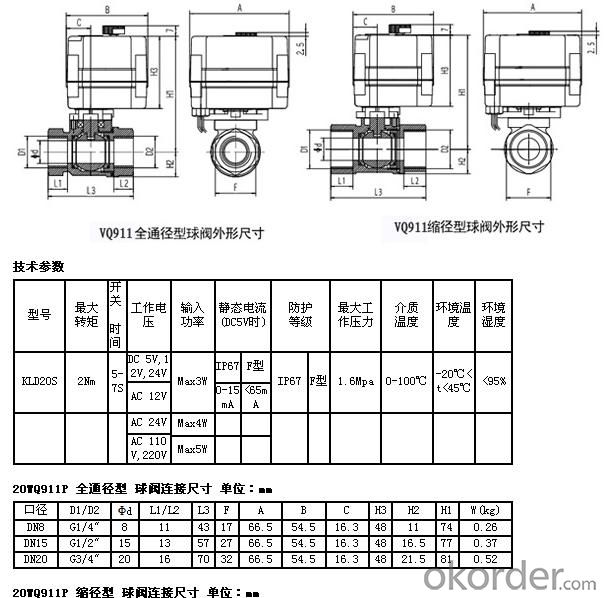
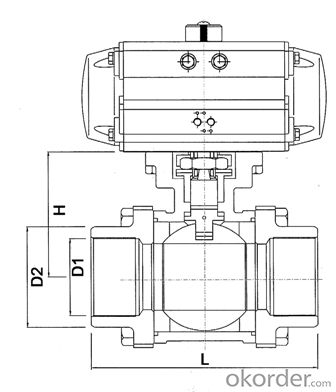
5.FAQ
1. What's are the characteristics of gate valve?
The distinct feature of a gate valve is the sealing surfaces between the gate and seats are planar, so gate valves are often used when a straight-line flow of fluid and minimum restriction is desired. The gate faces can form a wedge shape or they can be parallel.
2. What is the work principle of gate valve ?
The gate faces can form a wedge shape or they can be parallel. Gate valves are primarily used to permit or prevent the flow of liquids, but typical gate valves shouldn't be used for regulating flow, unless they are specifically designed for that purpose. Because of their ability to cut through liquids, gate valves are often used in the petroleum industry.
3. What is the structure?
Bonnets provide leakproof closure for the valve body. Gate valves may have a screw-in, union, or bolted bonnet. Screw-in bonnet is the simplest, offering a durable, pressure-tight seal. Union bonnet is suitable for applications requiring frequent inspection and cleaning. It also gives the body added strength. Bolted bonnet is used for larger valves and higher pressure applications.
- Q: The difference between flanged gate valve and common gate valve
- Flange valve: English name; Flange Gate Valve is the gate opening and closing parts, RAM direction of motion perpendicular to the direction of the fluid, valve can only be fully open and fully closed, can not be adjusted and the throttle. Gate has two sealing surface, the most commonly used mode gate valve of the two sealing surface to form a wedge, wedge angle with valve parameters vary, usually 50, medium temperature is not high when 2 degrees 52'. Wedge gate valve can be made into a whole, called the rigid gate; can also be made to produce micro deformation of ram, in order to improve its process of deviation, make up the sealing surface angle in the process, the gate is called the flexible gate.Ordinary gate valve: mainly used to connect or cut off the medium in the pipeline, not applicable to regulating medium flow. Gate valve applies to pressure, temperature and caliber range is great, especially for medium, large diameter pipesThe most important difference: flange gate valve and ordinary gate valve is different, flange gate valve quality, durable, easy to install, but higher prices, generally used for large pipelines. Ordinary gate valves are used for small caliber, easy to change places.
- Q: How to distinguish between gate valve and cut-off valve?
- Two can be closed, in the flow of linear requirements are not high, you can adjust the flow. Just because of its structural characteristics of the valve to make its flow resistance, so there is a demand for throttling with a little more than the gate valve. In addition, the cut-off valve, whether it is a formal or reverse installed, in the opening and closing process, there is always a very difficult, and therefore can not do a great deal, or it is not easy to open and close. In addition, the cut-off valve has a one-way sealing effect of good features, so in the prevention of reverse flow of the working fluid, it also has a place to play.Hope to be of some help to you!
- Q: Does the relief valve have a gate valve?
- No The front end must be in control.
- Q: What does gate z41t-10 150 mean?
- According to JB/T308-2004 "valve type programming method"Z gate valve4 flange connection1 Ming wedge single gateT sealing cover material is copper alloy10 nominal pressure PN10PN16 below no marked valve body code, body material is gray cast iron150 nominal size DN150
- Q: What do you mean by forged steel gate valves 800LB DN20 SW?
- Is the forged steel gate 800LB is DN20 on SW welding pressure
- Q: The valve safety valve check valve + + + = exposed part of a water pump adapter? Five
- Generally do not require safety valve, just install exhaust valve in individual places.
- Q: Yes, soft sealing gate valve can reach 25 kilograms, Fujian light valve company has this type of soft sealing gate valveAnonymous browsing | 28 times
- Soft seal butterfly valve seal is good, but can only withstand up to 16 pressure, or the plastic can not stand. A short period of time is OK, and it's also related to the workmanship and quality of the factory. The quality is poor.
- Q: About fire valve is gate valve or butterfly valve problems?
- Disease is generally in accordance with the design requirements, regardless of the butterfly or tie hair to meet the requirements, are two-way valve.
- Q: The main question is, what are the functional differences in which case?
- The gate (gate valve) is a gate opening and closing parts, RAM direction of motion perpendicular to the direction of the fluid, valve can only be fully open and fully closed, can not be adjusted and the throttle gate valve. The direction of motion perpendicular to the direction of the fluid, valve can only be fully open and fully closed, can not be adjusted and the throttle.Gate valve advantages: 1, fluid resistance is small,.2, opening and closing more labor-saving,.3, medium flow unrestricted, not disturbed flow, do not reduce pressure,.4, simple shape, structural length is short, manufacturing process is good, a wide range of applicationsValve shortcomings: 1, between the sealing surface is easy to cause erosion and abrasions, maintenance is more difficult,.2, big size, open need some space, opening and closing time is long,.3, the structure is more complex
- Q: Acid resistant alkali valve gate valve
- A products have few connections and good overall steel quality.B closure speed is fast.C opening limit mechanism is convenient, flexible and precise.
Send your message to us
DIN Cast Iron Resilient Seated Flanged Gate Valve F4
- Loading Port:
- Tianjin
- Payment Terms:
- TT OR LC
- Min Order Qty:
- 200 pc
- Supply Capability:
- 10000 pc/month
OKorder Service Pledge
OKorder Financial Service
Similar products
Hot products
Hot Searches
Related keywords



